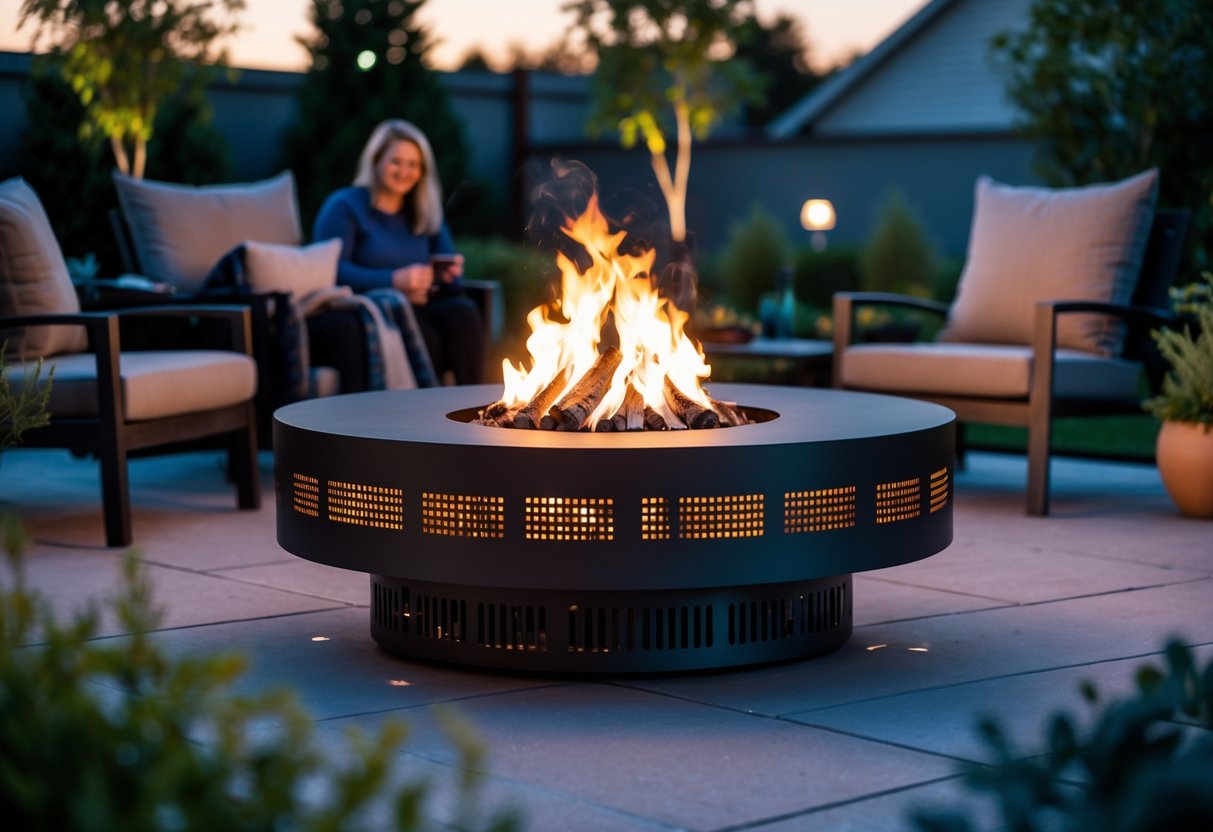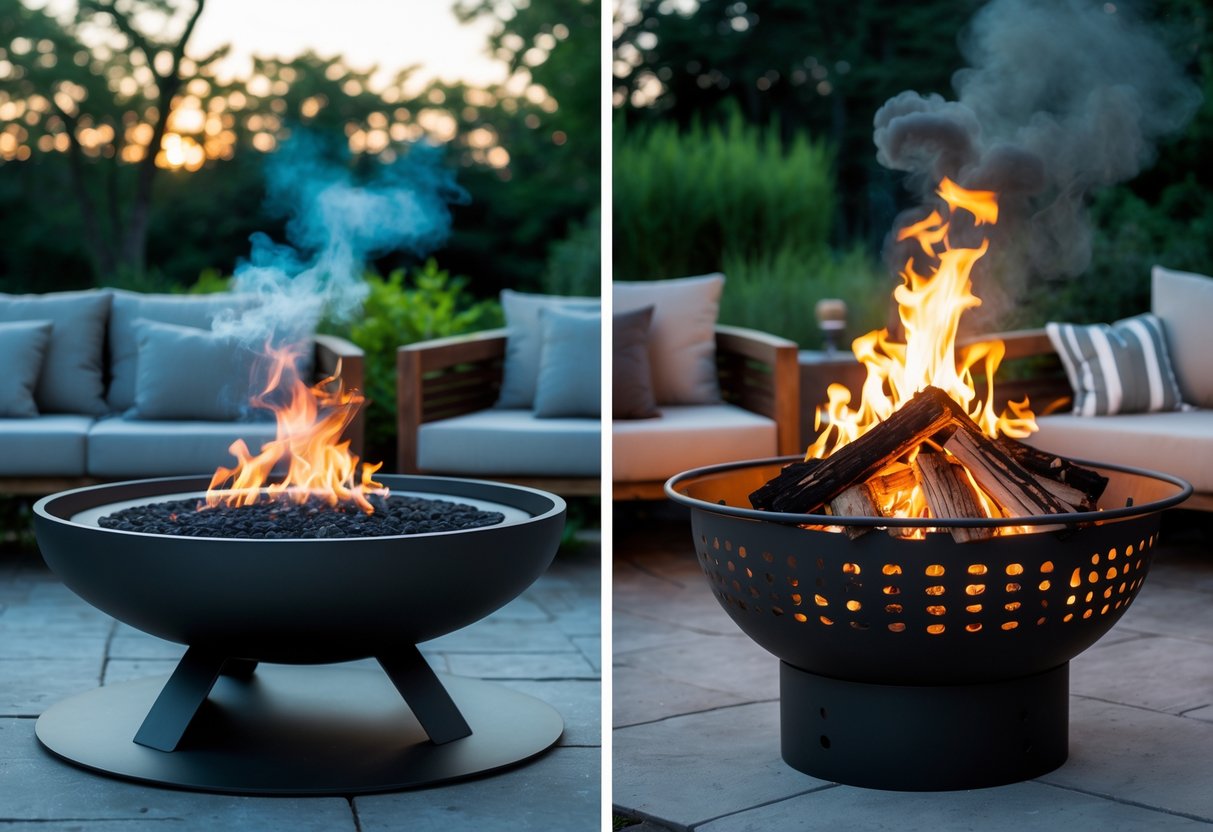Traditional campfires create wonderful ambiance but come with a major drawback: smoke that stings eyes and clings to clothing. Smokeless fire pits have emerged as a solution, using innovative double-wall designs to create secondary combustion that burns off most smoke-producing particles. These modern fire pits can reduce smoke by 70-80% compared to traditional open fires while maintaining the warmth and atmosphere people love.
The technology works by creating airflow through holes in the fire pit walls, providing extra oxygen that burns the gases that typically escape as smoke. This design change affects more than just smoke production—it influences heat output, fuel efficiency, and maintenance requirements. Understanding these differences helps buyers make informed decisions about whether smokeless technology suits their needs.
Several leading brands now offer smokeless fire pits in various sizes and configurations, from portable models for small patios to large units designed for cooking and entertaining. Each design brings unique advantages and limitations that affect performance, ease of use, and long-term satisfaction for outdoor enthusiasts seeking cleaner burning fires.
How Smokeless Fire Pits Work

Smokeless fire pits use double-wall construction and engineered airflow systems to create secondary combustion that burns off smoke particles. This design produces cleaner burning fires with significantly higher heat output than traditional fire pits.
Double-Wall and Airflow Design
The foundation of smokeless fire pit technology relies on double-wall construction with an inner and outer wall configuration. Small vent holes positioned at the bottom of the outer wall draw fresh air into the space between the walls.
As the fire heats up, this air becomes preheated while traveling upward through the narrow gap. The heated air then exits through larger holes at the top of the inner wall, creating a continuous smokeless fire pit airflow pattern.
This engineered airflow system ensures oxygen reaches the fire from multiple directions. The bottom vents supply primary combustion air, while the top vents deliver preheated secondary air above the flames.
The double-wall design also acts as insulation, keeping the inner fire chamber extremely hot. This high temperature environment is crucial for complete fuel combustion and smoke elimination.
Secondary Combustion Explained
Secondary combustion occurs when the preheated air from the double-wall system ignites unburned particles and gases above the primary fire. These particles would normally escape as visible smoke in traditional fire pits.
The process requires temperatures exceeding 1,100 degrees Fahrenheit to effectively burn off smoke-producing compounds. The double-wall design maintains these extreme temperatures consistently throughout the burn.
Key combustion stages:
- Primary combustion burns the main fuel source
- Heated air rises and mixes with unburned gases
- Secondary combustion ignites these gases at the top
- Nearly complete fuel consumption results
This two-stage burning process consumes up to 90% more of the wood’s combustible materials compared to standard fire pits.
Heat Output Differences
Smokeless fire pit heat output significantly exceeds traditional designs due to more complete fuel combustion. The secondary combustion process extracts additional energy from materials that would otherwise become smoke.
Most smokeless fire pits generate 20-30% more heat from the same amount of wood. The double-wall construction also radiates heat more efficiently, creating better warmth distribution around the fire pit.
The concentrated airflow creates hotter, more intense flames that burn fuel faster but more completely. Users typically experience stronger radiant heat within a 6-8 foot radius compared to conventional fire pits.
Higher combustion efficiency means less fuel waste and longer-lasting heat output. The improved burn characteristics also produce significantly less ash residue after each use.
Smokeless vs Traditional Fire Pits

Smokeless fire pits utilize advanced airflow technology and secondary combustion systems to minimize smoke production, while traditional models rely on basic wood burning. The differences between these designs significantly impact heat output, air quality, and maintenance requirements.
Smoke Reduction and Air Quality
Smokeless fire pits produce dramatically less smoke than traditional models through their double-wall construction and secondary combustion chambers. The advanced airflow design pulls air through vents at the bottom and reburns particles that would normally create smoke in traditional pits.
Traditional fire pits emit dense smoke clouds that irritate eyes and lungs. Users frequently need to move around the fire to avoid smoke direction changes based on wind patterns.
Well-designed smokeless models virtually eliminate eye-burning smoke clouds. The secondary combustion system burns wood particles more completely, resulting in cleaner air around the fire pit area.
Key differences in smoke production:
- Smokeless pits: Minimal visible smoke after initial lighting
- Traditional pits: Continuous smoke throughout burn time
- Air quality impact: Smokeless designs reduce respiratory irritation significantly
Performance and Heat Distribution
Smokeless fire pits generate more heat output while consuming less wood than traditional models. The compact double-wall design and efficient combustion system maximize fuel utilization and heat production.
Traditional fire pits lose significant heat through incomplete combustion and smoke production. Much of the wood’s energy escapes as unburned particles rather than usable heat.
Heat efficiency comparison:
- Smokeless: Higher heat output per log burned
- Traditional: Lower efficiency due to incomplete combustion
- Fuel consumption: Smokeless pits use approximately 30% less wood
The concentrated heat from smokeless designs provides more consistent warmth distribution. Traditional pits create uneven heating patterns with hot spots directly above the flames.
Ash and Cleanup Comparison
Smokeless fire pits produce significantly less ash due to their complete combustion process. The secondary burning chamber consumes most wood particles that would normally become ash in traditional pits.
Traditional fire pits generate substantial ash buildup requiring frequent cleaning. Incomplete combustion leaves behind partially burned wood pieces and charcoal remnants.
Maintenance requirements:
- Smokeless pits: Minimal ash removal needed after multiple burns
- Traditional pits: Regular ash cleaning required after each use
- Cleanup time: Smokeless models reduce maintenance by 60-70%
The reduced ash production in smokeless designs means less debris dispersal around the fire pit area. Traditional models often scatter ash particles during windy conditions, creating additional cleanup work.
Top Smokeless Fire Pit Models Reviewed
These four models represent the best options across different price points and use cases, from portable designs to cooking-focused units. Each offers distinct advantages in construction, features, and performance for various backyard setups.
Solo Stove Bonfire 2.0
The Solo Stove Bonfire 2.0 delivers excellent portability at 23.3 pounds with a 17.5-inch diameter opening. The double-wall stainless steel construction creates secondary combustion that reduces smoke by approximately 70-80% compared to traditional fire pits.
Key Features:
- Removable ash pan for easy cleanup
- Grade 304 stainless steel construction
- Limited lifetime warranty
- 14-inch height fits most patio spaces
The updated design eliminates the need to flip the unit for ash removal. Users can stack standard logs carefully due to the compact diameter. The heat projects upward rather than radiating outward, requiring a separate heat deflector accessory for maximum warmth.
Solo Stove offers the Bonfire Shield spark screen for $160, which includes removal tools. A fabric or metal cover protects the unit from rain and corrosion. The Bonfire works well for small gatherings and fits easily in garages or storage areas.
Breeo X Series 24
The Breeo X Series 24 excels as a combination fire pit and outdoor cooking station. The 23.5-inch opening accommodates larger logs while supporting extensive cooking accessories including griddles, grill grates, and pizza ovens.
Construction Options:
- Cor-Ten steel (develops patina)
- Stainless steel (+$200)
- 40.5-pound weight
- Limited lifetime warranty
The cooking accessories transform this unit into a complete outdoor kitchen replacement. The SearPlate Griddle, post and grill system, and kettle hook expand cooking possibilities beyond basic grilling.
Ash removal requires manual shoveling due to vent channels in the floor design. The unit develops grease stains and char marks when used for cooking regularly. Steel wool and grease-cutting soap become necessary maintenance items.
The X24 represents the second-smallest size in Breeo’s lineup. Larger models offer openings up to 40 inches for commercial-scale applications.
Tiki Brand Smokeless Patio Fire Pit
The Tiki Patio Smokeless Fire Pit weighs 45 pounds and blends traditional aesthetics with modern smokeless technology. The 17.5-inch opening matches the Solo Stove dimensions while offering a more classic appearance.
The powder-coated and stainless steel construction provides durability with an 18.75-inch height. The removable ash collection plate simplifies cleanup compared to flip-over designs.
Included Accessories:
- Fitted cover for weather protection
- Optional spark screen with poker tool
- Wood pellet starter packs available
The spark screen kit includes a multi-purpose poker with bottle opener functionality. Users can hang the screen on the rim while adding logs. The design integrates well with existing patio furniture and landscaping.
Heat projection follows the same upward pattern as other smokeless designs. Tiki offers a compatible heat deflector to redirect warmth toward seating areas. The two-year limited warranty covers manufacturing defects.
Inno Stage Smokeless Wood Pellet Fire Pit

The Inno Stage model uses wood pellets as primary fuel, offering consistent burn rates and minimal ash production. The pellet-fed design provides longer burn times with less frequent fuel additions compared to log-burning units.
Pellet System Benefits:
- Consistent heat output
- Reduced ash volume
- Easy fuel storage
- Precise burn control
The automated pellet feed mechanism maintains steady flames without constant attention. Users load pellets into the hopper system rather than stacking logs manually. The compact design suits smaller patios and balcony installations where space constraints limit larger units.
Pellet costs exceed traditional firewood expenses over time. The mechanical components require occasional maintenance and cleaning. Power requirements for the feed system limit placement options compared to purely manual fire pits.
This is the one I recommend/ or lets say like…while the pellets are more expensive, it is easy to control, start, move, clean, and enjoy! Here is the link at Amazon if you like it too? Click Here
The stainless steel construction resists corrosion while the compact footprint maximizes portability. Spark screens and covers are available as separate accessories for complete weather protection and safety compliance.
Choosing the Best Smokeless Fire Pit
The right smokeless fire pit depends on three critical factors: finding the proper diameter for your space and group size, evaluating portability features that match your usage patterns, and ensuring compatibility with essential accessories like spark screens and cooking attachments.
Optimal Fire Pit Size for Your Needs
The best smokeless fire pit size centers around pit diameter, which directly affects heating capacity and wood requirements. Most models range from 15 to 27 inches in diameter.
Small pits (15-17.5 inches) work best for 2-4 people in compact spaces. The Solo Stove Ranger at 15 inches fits tight patios but requires careful log stacking. Standard firewood often needs cutting to fit properly.
Medium pits (18-24 inches) accommodate 4-6 people comfortably. The 17.5-inch opening found in popular models like the Solo Stove Bonfire and Tiki Patio provides good heat output while maintaining portability.
Large pits (25+ inches) serve groups of 6-8 people and handle full-size logs without splitting. The Solo Stove Yukon at 27 inches produces substantial heat but weighs significantly more.
Weight matters for storage and mobility. Small models weigh 20-25 pounds, medium sizes range 40-50 pounds, and large pits exceed 50 pounds. Consider how often the pit will be moved before selecting size.
Portability and Design Features
Weight and construction materials determine how easily a fire pit moves between storage and use locations. Stainless steel models offer the best portability-to-durability ratio.
Lightweight options like the Solo Stove Bonfire at 23 pounds allow easy transport from garage to patio. These models suit users who store fire pits after each use or move them frequently.
Heavier designs such as the 45-pound Tiki Patio model provide stability but work better as permanent installations. The extra weight comes from thicker walls and powder-coated steel construction.
Ash removal systems vary significantly between brands. Models with removable ash pans or trays simplify cleanup compared to designs requiring manual shoveling. The Breeo X Series requires shoveling ash around internal vent channels, making maintenance more difficult.
Weather protection requirements affect usability. All smokeless fire pits need covers to prevent rain from mixing with ash and creating corrosive compounds. Some manufacturers include covers while others sell them separately.
Accessory Compatibility
Essential accessories extend functionality and safety, but compatibility varies between manufacturers and models. Consider accessory costs when comparing fire pit prices.
Spark screens provide crucial ember containment in fire-prone areas. Quality screens cost $160-200 but offer precise fitment and removal tools. The Solo Stove Shield includes lifting tools, while Tiki’s screen hangs on the rim during log additions.
Heat deflectors address the common issue of reduced radiant heat in smokeless designs. Most major brands offer deflectors that redirect heat downward toward seating areas rather than straight up.
Cooking accessories transform fire pits into outdoor cooking stations. Breeo offers the most extensive cooking system with griddles, grill grates, and pizza ovens. Solo Stove provides basic grill grate kits for their models.
Stand options enable deck use by protecting surfaces from heat damage. Stands typically add $100-150 to the total cost but allow safe operation on wooden decks and composite materials.
Practical Considerations and Safety Tips
Proper setup, maintenance, and safety practices determine the success of a smokeless fire pit experience. Deck installations require specific heat protection measures, while regular maintenance ensures optimal performance and longevity.
Using a Smokeless Fire Pit on a Deck
Never place a smokeless fire pit directly on deck surfaces. Wood and composite materials can warp, discolor, or ignite from concentrated heat exposure.
Essential heat protection includes:
- Fire-resistant deck pad (minimum 36″ diameter)
- Elevated stand creating airspace underneath
- Heat shield reflecting radiant heat away from deck
Clearance requirements for deck installations:
- From house exterior: 10-15 feet minimum
- From railings/furniture: 5 feet when in use
- From overhead structures: 10 feet minimum
Composite decks need extra protection. These materials soften at lower temperatures than natural wood. Use larger protective pads (48″ diameter) and additional insulation layers.
Wind direction affects placement. Position the fire pit where prevailing winds blow smoke away from seating areas and the home’s interior.
Weight distribution matters for deck integrity. Place fire pits near center spans or over support beams rather than at deck edges.
Safety Accessories and Practices
Keep fire suppression equipment nearby:
- Garden hose reaching the fire pit area
- Class A fire extinguisher for wood fires
- Sand bucket for emergency smothering
Essential safety tools include:
- Spark screen – Prevents ember escape during windy conditions
- Fire poker – Safely adjusts logs without hand proximity to flames
- Heat-resistant gloves – Protects hands when handling hot accessories
Fuel selection impacts safety. Use seasoned hardwoods with less than 20% moisture content. Avoid softwoods like pine that create excessive sparks and smoke.
Monitor children and pets constantly. Establish clear boundaries around the fire pit area. The exterior surfaces reach extremely high temperatures even during normal operation.
Check local regulations before installation. Many areas require permits for deck fire features or have seasonal burn restrictions.
Maintenance and Long-Term Durability
After each use, allow complete cooling before cleaning. Remove ash only when the fire pit reaches ambient temperature, typically the morning after use.
Monthly maintenance prevents performance degradation:
- Clean air intake holes with soft brushes
- Inspect for warping or rust spots
- Check protective barriers for damage
Seasonal care extends lifespan significantly. Store fire pits indoors during winter months when possible. Use weather-resistant covers for outdoor storage.
Quality materials determine longevity. Stainless steel models last 8-10 years with proper care. Budget options typically need replacement after 2-3 seasons.
Deep cleaning maintains smokeless performance. Remove accumulated debris from double-wall air channels annually. Blocked airflow reduces secondary combustion effectiveness.
Replacement indicators include warped walls, damaged air holes, or increased smoke production despite proper fuel use.
Pros and Cons of Smokeless Fire Pits
Smokeless fire pits offer significant advantages over traditional models, particularly in smoke reduction and fuel efficiency. However, they come with higher upfront costs and specific maintenance requirements that buyers should consider.
Key Advantages
Minimal Smoke Production Smokeless fire pits reduce smoke emission by up to 90% compared to traditional models. They achieve this through advanced airflow systems that create secondary combustion of smoke particles.
Users can sit around the fire without constantly moving to avoid smoke. Eyes and lungs experience less irritation during outdoor gatherings.
Enhanced Safety Features These fire pits produce fewer flying embers and sparks due to complete combustion. The contained design reduces fire hazards in residential areas with strict fire regulations.
Parents find them safer around children and pets. The reduced smoke also means better visibility around the fire area.
Fuel Versatility and Efficiency Most models burn seasoned hardwood, wood pellets, or charcoal effectively. The complete combustion process extracts more heat from less fuel compared to traditional fire pits.
Clean Burning Benefits Users avoid the lingering campfire smell on clothes and hair. Neighbors experience less smoke-related complaints and irritation.
Potential Drawbacks
Higher Initial Investment Smokeless fire pits cost significantly more than traditional models. Quality units range from $200 to $800, while basic fire pits start around $50.
Budget-conscious buyers may find the upfront cost prohibitive.
Fuel Requirements These fire pits require specific wood types for optimal performance. Wet or unseasoned wood produces more smoke and reduces efficiency.
Users must source properly dried hardwood or approved pellets. This limits convenience compared to burning any available firewood.
Maintenance Demands The airflow systems require regular cleaning to maintain smokeless operation. Ash and debris can block air vents and reduce performance.
Some models need periodic inspection of internal components. Gas-powered versions require fuel monitoring and tank refills.
Written by Outdoor Space Accents—practical, safety-first guides based on manufacturer specs, code-aware best practices, and real-world outdoor use.


